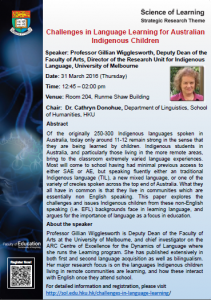Challenges in Language Learning for Australian Indigenous Children

Speaker: Professor Gillian Wigglesworth, Deputy Dean of the Faculty of Arts, Director of the Research Unit for Indigenous Language, University of Melbourne
Date: 31 March 2016 (Thursday)
Time: 12:45 – 02:00 pm
Venue: Room 204, Runme Shaw Building , HKU
Chair: Dr. Cathryn Donohue, Department of Linguistics, School of Humanities, The University of Hong Kong
Register
Abstract:
Of the originally 250-300 Indigenous languages spoken in Australia, today only around 11-12 remain strong in the sense that they are being learned by children. Indigenous students in Australia, and particularly those living in the more remote areas, bring to the classroom extremely varied language experiences. Most will come to school having had minimal previous access to either SAE or AE, but speaking fluently either an traditional Indigenous language (TIL), a new mixed language, or one of the variety of creoles spoken across the top end of Australia. What they all have in common is that they live in communities which are essentially non English speaking. This paper explores the challenges and issues Indigenous children from these non-English speaking (i.e. EFL) backgrounds face in learning language, and argues for the importance of language as a focus in education.
About the speaker:
Professor Gillian Wigglesworth is Deputy Dean of the Faculty of Arts at the University of Melbourne, and chief investigator on the ARC Centre of Excellence for the Dynamics of Language where she runs the Learning program. She has published extensively in both first and second language acquisition as well as bilingualism. Her major research focus is on the languages Indigenous children living in remote communities are learning, and how these interact with English once they attend school.



